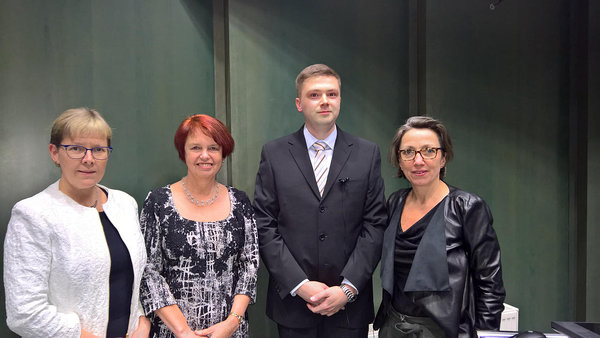Georgi Nellis defended PhD on March 06, 2017. The dissertation “The use of excipients in medicines administered to neonates
in Europe” was performed in the frame of ESNEE project. We all congratulate
George and thank dr. Catherine
Tuleu for leading stimulating discussion as the opponent.
Georg Nellis together
with Supervisors prof. Irja Lutsar, and dr. Tuuli Metsvaht and the opponent dr.
Catherine Tuleu after the defence.
Supervisors:
Professor Irja Lutsar (MD, PhD), Head of Department of Microbiology of Institute Biomedicine and Translational Medicine, University of Tartu
Associate Professor/Senior Research Fellow Tuuli Metsvaht (MD, PhD), Head of Children's Intensive Care Unit of Tartu University Hospital
Opponent:
dr Catherine Tuleu (PhD), Reader in Pharmaceutics, Director, Centre for
Paediatric Pharmacy Research, UCL School of Pharmacy, London - UK.
Summary:
Pharmaceutical excipients are essential components of medicines
necessary to maintain quality and patient acceptability. Due to organ
immaturity there is a higher risk of adverse effects associated with the
administration of excipients in neonates compared to adults. While
thousands of excipients are in use, only some have been associated with
the toxicity in neonates – excipients of interest (EOI). In this work
EOI included parabens, polysorbate 80, propylene glycol, ethanol,
benzoic acid, sodium benzoate, benzyl alcohol, sorbitol, saccharin
sodium and benzalkonium chloride. We aimed to describe the scale of
neonatal exposure to EOI in Europe, to identify factors related to EOI
administration and explore the opportunity of product substitution to
reduce exposure to EOI. We conducted a 3-day questionnaire (service
evaluation survey, SES) and a 1-day point prevalence study (PPS). We
showed a high correlation in the frequency of medicine use between the
two methods. The choice of method in future studies depends on the
research question, whether priority is given to a more comprehensive
list of products (SES) or individual exposure data (PPS). Altogether 20
and 21 countries with 115 and 89 units participated in the SES and PPS,
respectively. In the SES 313 active pharmaceutical ingredients (APIs)
representing 1065 products were registered. In the PPS 726 neonates
received 2199 prescriptions. One third of products contained EOI and two
thirds of the neonates were administered at least one of them. We found
regional variations in the administration of some EOI. This indicates
possibilities to use EOI-free products available in one but not another
country. Substitution of only the most frequently used products would
reduce the overall number of exposed neonates almost by a half. In
conclusion, EOI are not rare in medicines used in European neonatal
intensive care units, whereas EOI-free products available on the
European market allow to reduce neonatal exposure to EOI substantially.


Write first comment